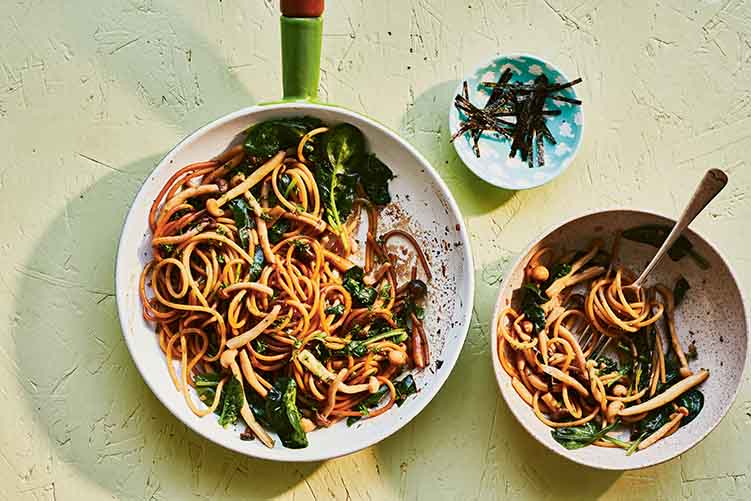
Prep Time: 10-15 minutes
Cooking Time: 20-25 minutes
Total Time: 30-40 minutes
Serving Size: 4 servings
NABE HITOTSU DE TSUKURERU KINOKO SHŌYU BATĀ WAFŪ PASUTA
鍋一つで作れるきのこ醤油バター和風パスタ
What makes something wafū? The word means ‘Japanese style’, so to answer this question, we have to consider the defining characteristics of Japanese culinary aesthetics. Or do we? Japanese conbini sell ‘wafū’ tuna mayo onigiri and sandwiches, which is just tuna mayo with added soy sauce and dashi. Likewise, wafū pasta is just pasta made with Japanese flavours, such as miso, umeboshi or mentaiko.
It’s funny, because it would be absurd if I or any other non-Japanese person declared that a dish was ‘Japanese style’ just because I added a few Japanese ingredients. But when the term is used by the Japanese, it becomes indicative of what could be considered to be important or distinctive about their own food. And maybe that’s not anything abstract or philosophical – maybe it’s just the flavours that are the most familiar. And that can still be a very powerful thing. So this pasta isn’t very different from something you might actually find in Italy, but the inclusion of soy sauce, nori and dashi does, in my mind, place it firmly in Japanese territory.
Ingredients:
- 40 g (1.5 oz) butter
- 1 tablespoon olive oil
- 400 g (14 oz) shiitake mushrooms, destemmed, cleaned and cut into bite-size pieces
- 4 garlic cloves, finely chopped
- 200 g (7 oz) fresh spinach (not baby spinach, if possible), washed and roughly chopped
- 4 tablespoons soy sauce
- 400 g (14 oz) spaghetti
- 1 tablespoon mirin
- ½ teaspoon dashi powder (for vegetarian ensure free of katsuobushi)
- pepper, to taste
- flat-leaf parsley leaves, finely chopped, to garnish
- 1 sheet of nori, cut into 4 strips and then into fine shreds with kitchen scissors
Method:
- Melt half of the butter in a saucepan large enough to cook the pasta in as well.
- Add the olive oil, mushrooms and garlic and cook over a medium-high heat for about 6 minutes until browned and slightly softened.
- Add the spinach and half the soy sauce and cook for another 2–3 minutes until the spinach is fully wilted.
- Scrape everything out of the pan and into a bowl or container.
- Fill the pan with water and bring to the boil, then add the spaghetti and cook until done, according to the package instructions (about 9–11 minutes).
- Drain well, but save about 100 ml of the pasta water. Mix the remaining soy sauce into the pasta water along with the mirin and dashi powder.
- Return the pasta to the pan along with the pasta water mixture, the mushrooms and spinach.
- Over a medium heat, stir everything together to combine, adding lots of pepper as you go.
- When the sauce has thickened, remove from the heat and add the remaining butter, stirring to melt it through the sauce.
- Garnish with the parsley, the nori shreds and more pepper, if you like, and serve hot.
This lasts for three days in the refrigerator, but is better eaten fresh.
Recipe taken from Tim Anderson's new book Japan Easy Bowls & Bento
JapanEasy Bowls & Bento by Tim Anderson (Hardie Grant, £25), Photography by Laura Edwards

